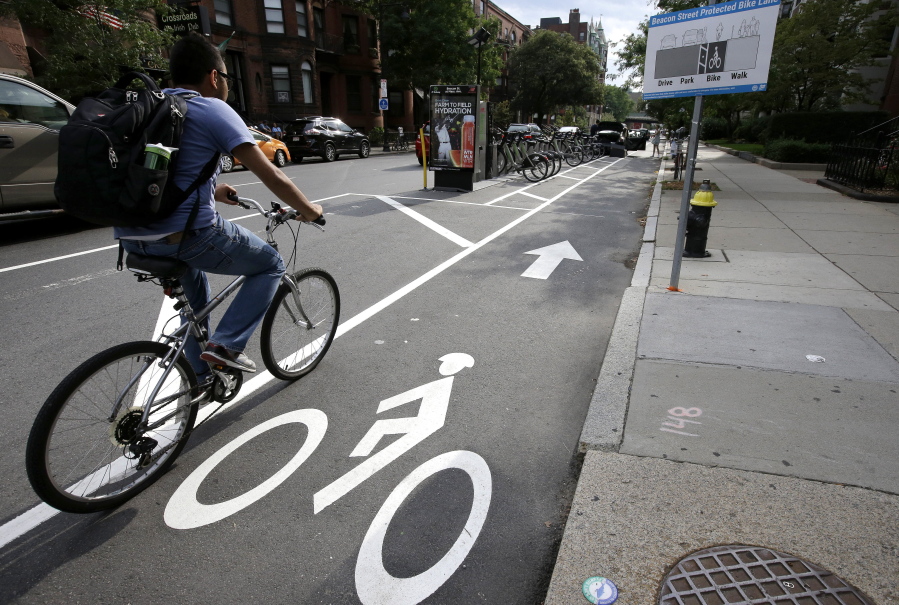BOSTON — Bike lanes are evolving, and cities making them safer after fatal crashes between cyclists and cars. All around the globe, traditional bike lanes are being replaced with protected lanes or cycletracks, in which curbs, planters or fences separate cyclists from vehicle traffic.
“For 50 years, we’ve just been putting down a stripe of white paint, and that was how you accommodated bikes on busy streets,” said Martha Roskowski, director of People for Bikes, a Boulder, Colo.-based advocacy group that’s calling for better bike lanes. “That simply doesn’t work for most.”
Here’s how bike lanes are changing around the world:
• WHERE IT’S HAPPENING: Protected lanes have been sprouting in the U.S. since at least 2007, when New York started using them.
Today, 94 U.S. cities have roughly 240 miles of protected lanes, according to People for Bikes. That’s an increase from about 100 miles of lanes in 32 cities in 2013, though still a fraction of all bike lanes, Roskowski said. This year, at least two dozen cities have so far installed new types of lanes, the group reports.
In Chicago, Mayor Rahm Emanuel has promised to build 50 miles of the lanes in the next three years in addition to 9 miles this year. And in greater Boston, where recent fatal cycle accidents have prompted calls for better lanes, a short stretch of Beacon Street leading to the Fenway Park area has been reconfigured. Rows of parked cars now serve as a buffer to cyclists, and there are plans to extend that path and incorporate the design on other major arteries.
• NOT CREATED EQUALLY: Designs for protected lanes vary by city, and not all have been warmly received.
Along a short part of San Francisco’s Market Street, pavement nearest the curb was recently built higher than vehicle lanes to create a distinct path for bikes. But Chris Cassidy of the San Francisco Bicycle Coalition said the city’s first test of a raised bike lane still leaves something to be desired, because vehicles are parking in the lane.
In Washington, D.C., the bike lane along Pennsylvania Avenue between the Capitol and White House has proved popular since it was installed in 2010. But some advocates grumble about its design — in the center of the broad thoroughfare — as impractical and unsafe. Greg Billing of the Washington Area Bicyclist Association said the center lane design won’t be repeated as the lane is extended past the White House. New rubber barriers also were installed last year to discourage cars from making illegal U-turns through the bike lane.
• LOCAL OPPOSITION: Among the most bitter bike lane disputes is the ongoing, five-year legal battle waged by wealthy and powerful residents in Brooklyn, N.Y.
Construction of a parked-car-protected bike path along Prospect Park required elimination of one vehicle lane in 2010. Norman Steisel, a former deputy mayor, said he and other Park Slope residents dispute the traffic and safety data on which the city based its final decision.
“You’ve got to be somewhat respectful for how you get these things done,” he said.
In central Philadelphia, some two-lane roads are slated to lose a vehicle lane to accommodate protected bike lanes. Jonathan Broh of the city’s Washington Square West Civic Association said he worries that stores will have a harder time receiving deliveries, and that school bus and taxi pickups will snarl traffic.
• EUROPE MORE ADVANCED: Protected bike lanes aren’t new in many European cities, where they’ve been around for decades.
Even cities with less biking are embracing the lanes. London opened a number of cycle superhighways that may eventually crisscross the city. Cyclists on these routes are separated from vehicle traffic by a curb. The city also has seen proposals for elevated bike highways spanning the Thames River or running above railway lines, as well as underground bike paths using old subway tunnels.
• ASIA AND BEYOND: Tokyo and other Japanese cities have long had a strong cycling culture, but some of their protected lanes are placed on sidewalks. That presents challenges, as cyclists and pedestrians compete for space, said Mikael Colville-Andersen, CEO of Copenhagenize Design Co., a Danish bike infrastructure project firm.
Two of China’s largest cities, Guangzhou and Shanghai, also are investing heavily in protected lanes and other bike infrastructure, experts said.
In South America, Buenos Aires, Argentina, has built nearly 90 miles of bike lanes, many of them protected, in just three years.



